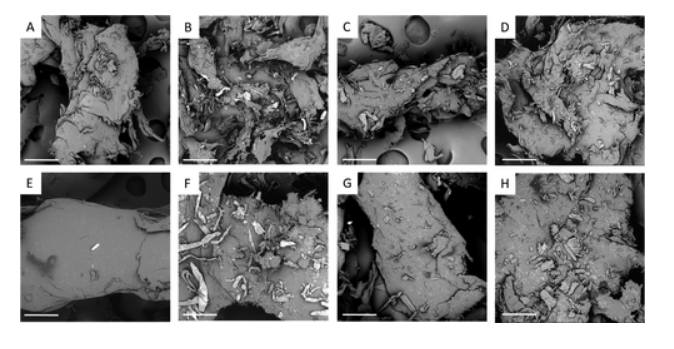In this recently published study, ‘Recycled Cellulose Polypropylene Composite Feedstocks for Material Extrusion Additive Manufacturing,’ researchers from the US explain their findings in using not only composites but those made out of recycled material. Here, the focus is on using polypropylene reinforced with cellulose waste to create 3D printing filament for material extrusion additive manufacturing (MEAM).
With cellulose being more commonly used to strengthen thermoplastics, today, such composites can be helpful in applications such as decking, paneling, furniture, household goods, and more. Not only are they plentiful, but also affordable to use—and best of all, renewable. Such materials also offer strength, low-bulk density—along with less abrasion, meaning that products last longer. To date, many studies have centered around ABS and PLA composites; in fact, some have even included using materials like ground-up macadamia shells with ABS.
For this study, materials like wastepaper, cardboard, and wood flour were used for additives, with powders melted into filament and then printed into samples for testing, considering that mechanical properties could be affected due to filler, along with wettability.
“Strong particle–matrix interfacial adhesion can improve toughness due to efficient stress transfer between phases,” stated the researchers. “On the other hand, poor wetting can lead to debonding, plastic void growth, and shear banding mechanisms, which absorb energy and can improve toughness.”
The composites were created through pulverization, minimizing particles for better results in fabricating samples. The ingredients used for the composite were rather interesting too, in the form of Wegmans and Great Value yogurt containers, along with office printer paper, corrugated cardboard, and wood flour.
“Recycled polypropylene from yogurt containers was cleaned by rinsing with water, ethanol and drying in the air at room temperature. The labels were removed before cutting into pieces that could be fed into the paper shredder (Compucessory model CCS60075). Wastepaper and cardboard were fed through an identical cross-paper shredder,” explained the researchers.

Recycled PP and cellulose starting materials, powder, and filament generated from SSSP. (A) Waste paper, (B) rPP/WP SSSP powder, (C) rPP/WP filament, (D) rPP shreds, (E) rPP/CB SSSP powder, (F) rPP/CB filament, (G) wood flour, (H) rPP/WF SSSP powder, (I) rPP/WF filament. WP = waste paper, CB = cardboard, WF = wood flour.
While all the samples were 3D printed as planned, the researchers pointed out that clogging was an issue for some pieces when using the typical 0.5 mm nozzle. The team theorized that cellulose was responsible for the clogging due to some particles not ground finely enough. Cardboard and paper did not always remain sufficiently mixed either. 3D printing was performed on a Lulzbot Taz 6 3D printer, with a 100 °C bed temperature and a 220 °C nozzle temperature used.
“Sections along the length of a filament spool were examined by scanning electron microscope and thermogravimetric,” concluded the researchers. “The rPP/CB composites have a greater loading of cellulose compared to the commercial PP (cPP)/CB composites, but loading does not change significantly along the ca. 30 ft. examined. Further, weight percent remaining by TGA does not show significant differences in char along each respective filament.”

Ultimate tensile strength (hatched bars) and modulus (solid bars) of printed PP with 10 wt % cellulose. *, **, # significantly different from the respective control. WP = waste paper, CB = cardboard, WF = wood flour.
While 3D printing today offers a host of different materials to choose from as a whole, many are better when reinforced, meaning that composites are becoming increasingly more popular from copper metal to continuous wire polymers or continuous carbon, and more—even to include alternatives like wood and cork.
What do you think of this news? Let us know your thoughts! Join the discussion of this and other 3D printing topics at 3DPrintBoard.com.

Ultimate tensile strength (hatched bars) and modulus (solid bars) of printed PP with 10 wt % cellulose. *, **, # significantly different from the respective control. WP = waste paper, CB = cardboard, WF = wood flour.
Subscribe to Our Email Newsletter
Stay up-to-date on all the latest news from the 3D printing industry and receive information and offers from third party vendors.
You May Also Like
Precision at the Microscale: UK Researchers Advance Medical Devices with BMF’s 3D Printing Tech
University of Nottingham researchers are using Boston Micro Fabrication‘s (BMF) 3D printing technology to develop medical devices that improve compatibility with human tissue. Funded by a UK grant, this project...
3D Printing Webinar and Event Roundup: April 21, 2024
It’s another busy week of webinars and events, starting with Hannover Messe in Germany and continuing with Metalcasting Congress, Chinaplas, TechBlick’s Innovation Festival, and more. Stratasys continues its advanced training...
3D Printing Webinar and Event Roundup: March 17, 2024
It’s another busy week of webinars and events, including SALMED 2024 and AM Forum in Berlin. Stratasys continues its in-person training and is offering two webinars, ASTM is holding a...
3D Printed Micro Antenna is 15% Smaller and 6X Lighter
Horizon Microtechnologies has achieved success in creating a high-frequency D-Band horn antenna through micro 3D printing. However, this achievement did not rely solely on 3D printing; it involved a combination...





























